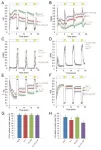(Press-News.org) Washington, D.C. — A new study has demonstrated rapid and sensitive on-site detection of SARS-CoV-2 RNA from environmental surfaces using a portable laboratory device. The study was published in Microbiology Spectrum, a journal of the American Society for Microbiology.
“Our findings hold promising implications for scenarios where access to testing laboratories is challenging, such as in cruise ships, international travel, remote islands and tourist destinations,” said lead study author Kouichi Kitamura, Ph.D., National Institute of Infectious Diseases, Tokyo, Japan. “Our developed methods could be utilized for point-of-care testing and sensitivity-demanding applications like risk assessment. From a One Health perspective, ensuring food hygiene in forestry, agriculture, aquaculture and livestock production to distribution is vital. However, these industries often operate far from commercial testing labs, underscoring the importance of establishing on-site detection methods.”
The researchers conducted this study to develop an on-site virus detection method, mainly for SARS-CoV-2, for environmental surfaces, to monitor pathogens using portable devices without access to laboratory settings. While rapid detection methods like antigen tests and loop-mediated isothermal amplification (LAMP) assay are available as point-of-care testing solutions, PCR is often considered the gold standard for pathogen detection with high sensitivity and specificity. “Portable PCR devices allow us to leverage established PCR conditions for detecting various pathogens, making them highly valuable,” Kitamura said.
The researchers envisioned detecting viruses present on commonly touched surfaces like doorknobs and tabletops. They conducted experiments by dropping non-infectious viral particles, not limited to SARS-CoV-2, onto several materials such as plastic and stainless steel, then let them dry and collected the particles from surfaces with swabs. They then explored methods to detect the viruses using only portable equipment.
Using commercially available swab kits and a portable PCR device, the researchers demonstrated the feasibility of rapid on-site virus detection. Additionally, they developed a method to extract viral RNA using another portable experimental device (a compact centrifuge), enabling highly sensitive on-site detection even for very small quantities of viruses.
“This study presents an end-to-end on-site virus detection method, covering sample collection to PCR testing,” Kitamura said. “We encourage the adoption of the testing approach demonstrated in this research, especially in situations requiring high-sensitivity rapid diagnostics in contexts where access to testing laboratories is limited.”
###
The American Society for Microbiology is one of the largest professional societies dedicated to the life sciences and is composed of 30,000 scientists and health practitioners. ASM's mission is to promote and advance the microbial sciences.
ASM advances the microbial sciences through conferences, publications, certifications, educational opportunities and advocacy efforts. It enhances laboratory capacity around the globe through training and resources. It provides a network for scientists in academia, industry and clinical settings. Additionally, ASM promotes a deeper understanding of the microbial sciences to diverse audiences.
END
Portable laboratory devices can detect SARS-CoV-2
2023-10-04
ELSE PRESS RELEASES FROM THIS DATE:
Challenges in acute heart attack care continue post COVID-19
2023-10-04
A door-to-balloon (D2B) time of 90-minutes or less is associated with improved outcomes for heart attack patients. However, during the COVID-19 pandemic certain obstacles—including the need for COVID-19 screening, associated isolation procedures and terminal cleaning in the cardiac cath lab—led to increased D2B times. According to a new study, presented at the American College of Cardiology (ACC) Quality Summit 2023, many health care facilities are still recovering from the pandemic and facing new challenges, causing D2B times to continue to lag.
A myocardial infarction, or heart attack, occurs when there has been a blockage ...
Researchers design potential therapy to prevent brain deterioration in children with rare genetic conditions
2023-10-04
Francis Crick Institute press release
Under strict embargo: 14:00 BST / 09:00hrs ET Wednesday 4 October 2023
Peer reviewed
Observational and experimental studies
People and cells
A research team at the Francis Crick Institute and Great Ormond Street Hospital (GOSH)/UCL Great Ormond Street Institute of Child Health have identified new potential treatments for children with rare genetic conditions of blood vessels, which cause severe, lifelong, and disabling symptoms like seizures and impaired development.
Through two papers published today in the Journal of Investigative ...
Reactivate, repurpose, and rewire the brain
2023-10-04
Developing brains become shaped by the sights, sounds, and experiences of early life. The brain’s circuits grow more stable as we age. However, some experiences later in life open up opportunities for these circuits to be rapidly rewired. New research from Cold Spring Harbor Laboratory Associate Professor Stephen Shea helps explain how the brain adapts during a critical period of adulthood: the time when new mothers learn to care for their young.
Shea’s work in mice shows how this learning process ...
American Society for Metabolic and Bariatric Surgery names new executive director after yearlong search
2023-10-04
After a yearlong and extensive nationwide search, the American Society for Metabolic and Bariatric Surgery (ASMBS), the nation’s largest professional organization of bariatric and metabolic surgeons and integrated health professionals, has named healthcare association veteran Diane M. Enos MPH, RDN, CAE, FAND, to serve as its new executive director.
Before joining ASMBS, Enos, a registered dietitian and certified association executive with a master’s degree in public health from the University of Texas Health Science Center in Houston, was Chief Learning Officer of the Academy of Nutrition and Dietetics, ...
Antibody therapy inspired by patient case reduced tau tangles in a preclinical model of Alzheimer’s disease
2023-10-04
A team led by researchers from Mass General Brigham reports promising results for a monoclonal antibody that takes aim at a new target for Alzheimer’s disease. Inspired by their previous identification of a genetic variant in the APOE gene that provides extreme resistance against Alzheimer’s disease, the team, which includes investigators from Mass Eye and Ear and Massachusetts General Hospital, developed a therapy that mimics the behavior of this genetic variant in a preclinical model, reducing ...
Demystifying the role of plant x- and y-type thioredoxins
2023-10-04
The potential for exposure to fluctuating light has necessitated that plants evolve protective mechanisms for when the light intensity exceeds photosynthetic capacity. Under these conditions, reactive oxygen species cause photoinhibition, which hinders photosynthetic efficiency. To counter this loss in photosynthetic efficiency, chloroplasts evolved thioredoxin (Trx) proteins that regulate redox balance within the photosynthetic apparatus and provide a photoprotective function. These proteins allow plants to modulate photosynthesis in response to variations in light intensity. ...
Graphene oxide reduces the toxicity of Alzheimer’s proteins
2023-10-04
A probable early driver of Alzheimer's disease is the accumulation of molecules called amyloid peptides. These cause cell death, and are commonly found in the brains of Alzheimer’s patients. Researchers at Chalmers University of Technology, Sweden, have now shown that yeast cells that accumulate these misfolded amyloid peptides can recover after being treated with graphene oxide nanoflakes.
Alzheimer’s disease is an incurable brain disease, leading to dementia and death, that causes suffering for both the patients and their ...
Avatars to help tailor glioblastoma therapies
2023-10-04
Scientists have created a new zebrafish xenograft platform to screen for novel treatments for an aggressive brain tumor called glioblastoma, according to a new study by the Gerhardt and De Smet labs published in EMBO Molecular Medicine.
Joint press release – Max Delbrück Center, VIB, and KU Leuven
Glioblastoma is an aggressive and difficult-to-treat brain tumor in adults. On average, patients survive for only 1.5 years. The standard of care treatment for this disease, which includes surgery followed by radiation and chemotherapy, has not changed in 18 years. That’s partly because the cancer is ...
Oxford researchers develop 3D printing method that shows promise for repairing brain injuries
2023-10-04
Researchers have produced an engineered tissue representing a simplified cerebral cortex by 3D printing human stem cells.
When implanted into mouse brain slices, the structures became integrated with the host tissue.
The technique may ultimately be developed into tailored repairs to treat brain injuries.
A breakthrough technique developed by University of Oxford researchers could one day provide tailored repairs for those who suffer brain injuries. The researchers demonstrated for the first time that neural cells can be 3D printed to mimic the architecture of the cerebral cortex. The results have been published today in the ...
Tracking the bacteria behind life-threatening sepsis in premature babies
2023-10-04
Premature babies in neonatal care units are extremely vulnerable, and susceptible to life-threatening infections. To help keep these babies safe the risk of infection needs to be kept as low as possible.
A particular problem is late onset sepsis that starts from three days after birth, when bacteria get into the blood and grow. This can be very dangerous and babies with late onset sepsis end up staying in hospital longer, need more treatment with antibiotics and can be left with life-long effects on their health.
Bacteria from the Staphylococcus family are the most common causes ...




